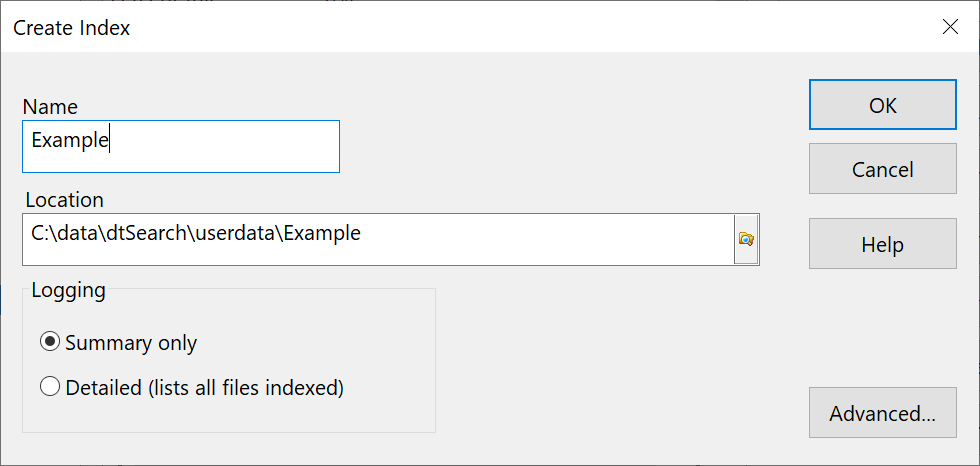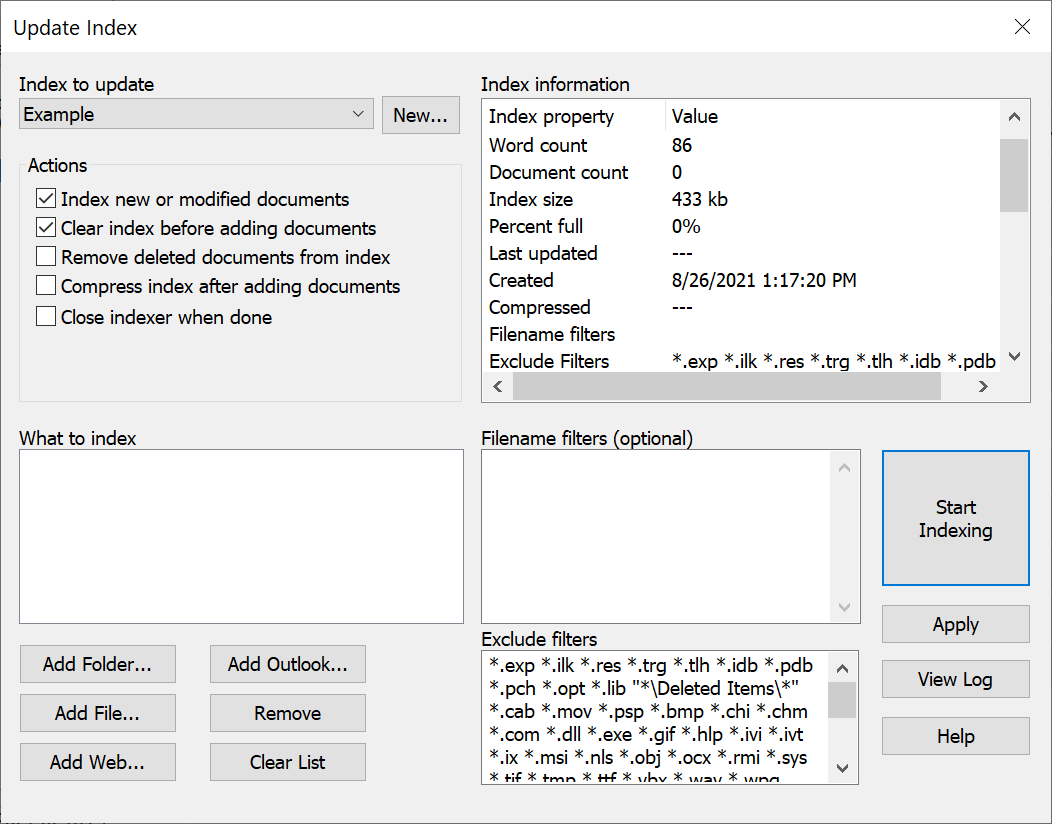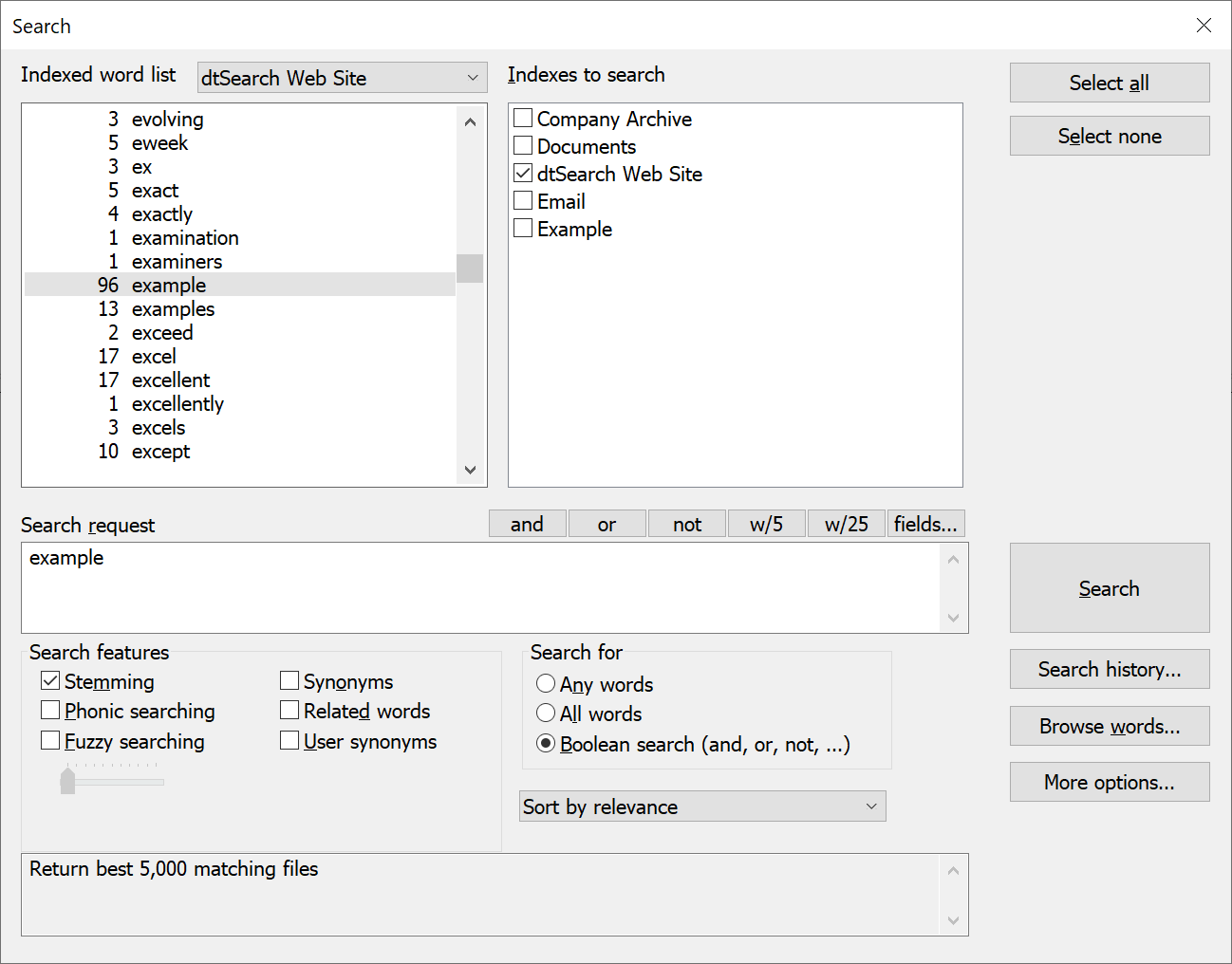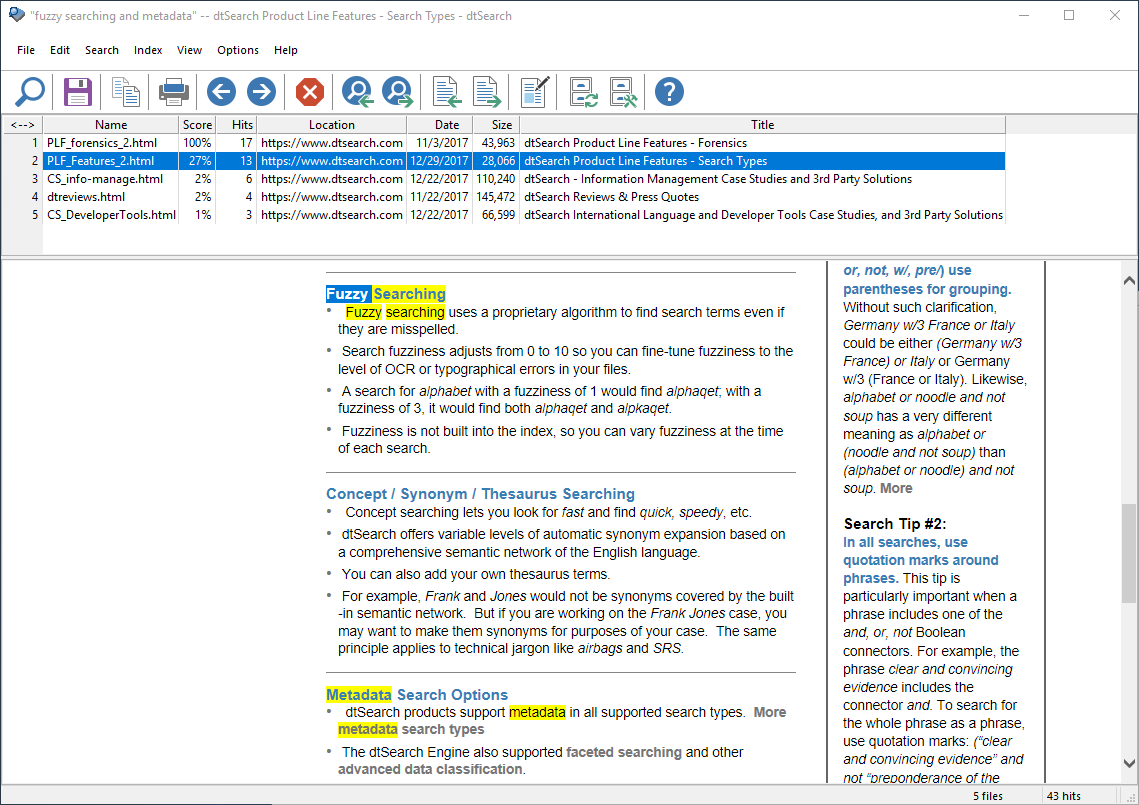Quick Start
dtSearch can search terabytes of text in a second. It does this by building an index that stores the location of each word in your files. Therefore, to get started with dtSearch, the first step is to build an index of your documents.
Indexing Documents
1. Click Index > Create Index.
2. In the Create Index dialog box, enter a name for the index and click OK.

3. dtSearch will ask if you want to add documents to the index. Click Yes to go to the Update Index dialog box.

4. Add documents to the index
Click Add Folder... to add a folder to the list of folders to index.
Click Add Web... to index a site using the dtSearch Spider.
Click Add Outlook... to add folders from your Outlook profile to the index.
5. Click Start Indexing to begin adding documents to your index.
Updating an Index
If you edit your original documents, you will need to update your index to reflect the changes (otherwise, hit highlighting will be incorrect).
To update your index, click Index > Update Index (or press Ctrl+U). Check the Index new or modified documents box and the Remove deleted documents box, and then click the Start Indexing button.
To schedule automatic updates of your indexes, click Index > Index Manager > Schedule Updates.
Supported File Types For a list of the file formats that dtSearch supports, see "What file formats does dtSearch support" at https://support.dtsearch.com.
Indexing Large Document Collections For suggestions to improve indexing of large document collections, see "Optimizing indexing of large document collections" at https://support.dtsearch.com.
Searching using the Index
1. Click the Search button on the dtSearch toolbar, or press Ctrl+S, to open the Search dialog box.
Indexes to search
The top right of the dialog box shows a list of the indexes you have created; select one or more to search.
Indexed word list
The top left of the dialog box shows a list of the words in the currently selected index. If more than one index is selected for searching, you can select the index to display in the word list by clicking the down arrow above the word list.

2. Enter a search under Search request.
3. Select any items under Search features (such as fuzzy searching) that you want to use.
4. Click Search to begin the search.
Search Types
Any words or All words
Finds a list of words or phrases
-
use "quotation marks" around phrases
-
add + in front of any word or phrase to require it
-
add - in front of any word or phrase or to exclude it
-
examples:
banana pear "apple pie"
"apple pie" -salad +"ice cream"
Boolean search
Finds a structured group of words or phrases linked by and, or, not, w/.
-
Examples:
tart apple pie – the entire phrase must be present
apple pie and pear tart – both phrases must be present
apple pie or pear tart – either phrase must be present
apple pie and not pear tart - only apple pie must be present
apple w/5 pear – apple must occur within 5 words of pear
apple not w/27 pear - apple must not occur within 27 words of pear
subject contains apple pie – finds apple pie in a subject field -
Use ( ) when a search includes two or more connectors:
apple and pear or orange could mean (apple and pear) or orange, or it could mean apple and (pear or orange)
Search Features
Stemming
Finds grammatical variations on endings, like applies, applied, applying in a search for apply
Fuzzy searching
Finds words even if they are misspelled. A search for alphabet with a fuzziness of 1 would also find alphaqet. With a fuzziness of 4, the same search would find both alphaqet and alpkaqet
Phonic searching
Finds words that sound alike, like Smythe in a search for Smith
Synonym searching
Finds word synonyms using a comprehensive English language thesaurus or user-defined custom thesaurus terms
Special Characters
? matches any single character
appl? matches apply or apple
* matches any number of characters
appl*ion matches application
~~ indicates numeric range
14~~18 looks for 14, 15, 16, 17 or 18
= matches any single digit
p12== matches p1234
Variable term weights
A number after a word assigns a specific positive or negative weight when ranking retrieved documents.
Example: apple:5 salad:-2
More Search Options
To search without an index, or to search by filename, date, or size, click the More Search Options tab.
To view or reuse a prior search request, click the Search History tab in the Search dialog box.
For information on forensic searching, see Forensics-related features
Viewing Search Results
After a search, dtSearch will display the results of the search. The top half of the dtSearch window will list all of the files retrieved in the search, and the lower half will show the first document in the list, with hits highlighted.

1. To select a document to view from the search results list, double-click on it.
2. To jump to the next hit in a document window, click Next Hit  on the button bar (or press SPACEBAR).
on the button bar (or press SPACEBAR).
Click the Next Doc  button (or press CTRL+SPACEBAR) to go to the next document.
button (or press CTRL+SPACEBAR) to go to the next document.
3. To change the way search results are sorted, click on one of the column headers (Name, Score, Location, Date, etc.).
4. Click the Launch  button (or press F8) to open a document in the application associated with it. For example, a Word document would be launched in Microsoft Word.
button (or press F8) to open a document in the application associated with it. For example, a Word document would be launched in Microsoft Word.
See "Keyboard shortcuts" in the on-line help for a complete list of keyboard shortcuts.
Create a Quick Summary of Your Search Results
An easy way to see the hits in all retrieved documents is to build a search report. A search report shows all hits along with the amount of context that you request.
1. Click Search > Search Report. The Generate Search Report dialog box will appear.
2. Enter the number of words (or paragraphs) of context that you want dtSearch to include in your search report and click OK to generate the report.
3. The search report will open in your word processor so you can edit or print it.